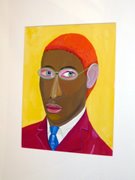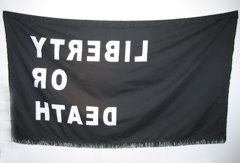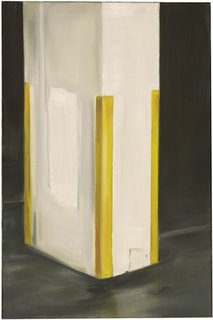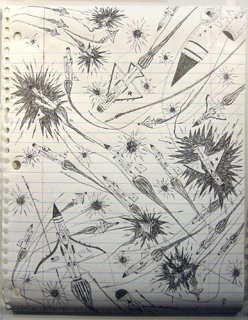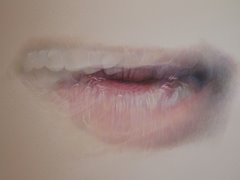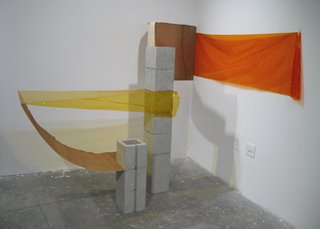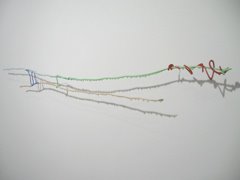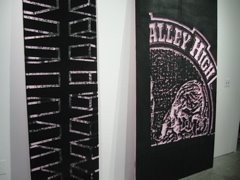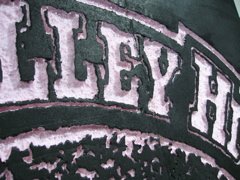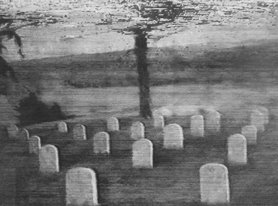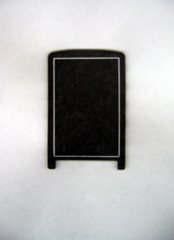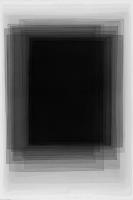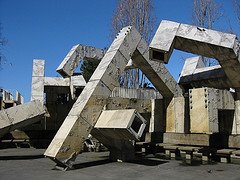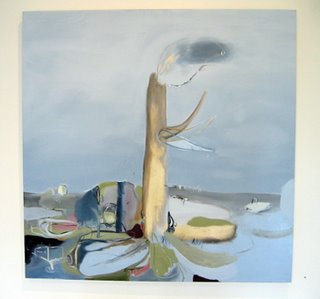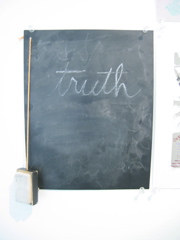 When I was in New York, I visited the Studio Museum Harlem (on March 12th) to see the “Frequency” show, a mini-survey of young black artists. This included flat work, sculptures, installations, and about an hour of videos.
When I was in New York, I visited the Studio Museum Harlem (on March 12th) to see the “Frequency” show, a mini-survey of young black artists. This included flat work, sculptures, installations, and about an hour of videos.One of my favorites in the show was Jeff Sonhouse, who makes eye-popping portraits in which black male faces look out from a variety of mask-like coverings. Unconventional materials are used, such as matchsticks for hair. A dazzling portrait diptych was seen near the entryway, the figures posed as in mug shots. Then came a larger piece in which the pose of Cardinal Francis Arinze (who was shortlisted to succeed John Paul II) recalled the Pope paintings of Velasquez and Francis Bacon. Photographs make these works look flat and hard-edged, but that is not the effect in person. They are electric. (Nevertheless, I am providing an image, above, adapted from Kustera Tilton Gallery.)
 Several of Demetrius Oliver’s performative photographs were on view. The most visceral of these is called “Till,” a reference (I assume) to the infamous 1955 murder and mutilation of black teenager Emmett Till in Mississippi. The photo shows the artist’s face covered with chocolate frosting, as if the face had become pulp (photo at right, taken from the net). Oliver has a gift, but his images can come across as an ad campaign for social justice—donate now. Another photographer in the show was Hank Willis Thomas, whose work is often meant to look like ads, but ones that implode. One of his well-known images was here: the profile of a black man’s shaved head with the Nike Inc. “swoosh” across it like a welt.
Several of Demetrius Oliver’s performative photographs were on view. The most visceral of these is called “Till,” a reference (I assume) to the infamous 1955 murder and mutilation of black teenager Emmett Till in Mississippi. The photo shows the artist’s face covered with chocolate frosting, as if the face had become pulp (photo at right, taken from the net). Oliver has a gift, but his images can come across as an ad campaign for social justice—donate now. Another photographer in the show was Hank Willis Thomas, whose work is often meant to look like ads, but ones that implode. One of his well-known images was here: the profile of a black man’s shaved head with the Nike Inc. “swoosh” across it like a welt. Nick Cave offered three extraordinary costumes assembled from pieces of sequined cloth. The garments, displayed on mannequins, covered the heads and extended higher, coming to a peak like the Pope’s hat. They looked like something from a sensational ethnographic museum (photo at right, adapted from the Jack Shainman site). I was also intrigued by the sculptural installation by Karyn Olivier (“Doubles”). She gets a striking effect from a pared-down style. The piece is hard to describe, and I was not permitted to make photographs. I look forward to seeing more of her work. Leslie Hewitt’s “riffs on real time,” which layer faded photos, pages from old school notebooks, and other memorabilia on top of carpet rectangles, evoke real feelings with humble means. Kianga Ford’s soundscape installation did not work as well here as it did at the Lisa Dent Gallery in San Francisco.
Nick Cave offered three extraordinary costumes assembled from pieces of sequined cloth. The garments, displayed on mannequins, covered the heads and extended higher, coming to a peak like the Pope’s hat. They looked like something from a sensational ethnographic museum (photo at right, adapted from the Jack Shainman site). I was also intrigued by the sculptural installation by Karyn Olivier (“Doubles”). She gets a striking effect from a pared-down style. The piece is hard to describe, and I was not permitted to make photographs. I look forward to seeing more of her work. Leslie Hewitt’s “riffs on real time,” which layer faded photos, pages from old school notebooks, and other memorabilia on top of carpet rectangles, evoke real feelings with humble means. Kianga Ford’s soundscape installation did not work as well here as it did at the Lisa Dent Gallery in San Francisco.The video program included a couple of strong pieces that were compromised by poor technical quality. Michael Paul Britto’s “Dirrrty Harriet Tubman” was loose and funny, and then he topped himself with a second video in which women as slaves or maids made housework gestures as they danced like backup singers to Britney Spears’s “I’m a Slave 4U.” Kalup Linzy’s “Conversations” featured gay men in daytime soap situations, with marriage as the big question. Both of these artists should be given some good video equipment and a budget, pronto.

